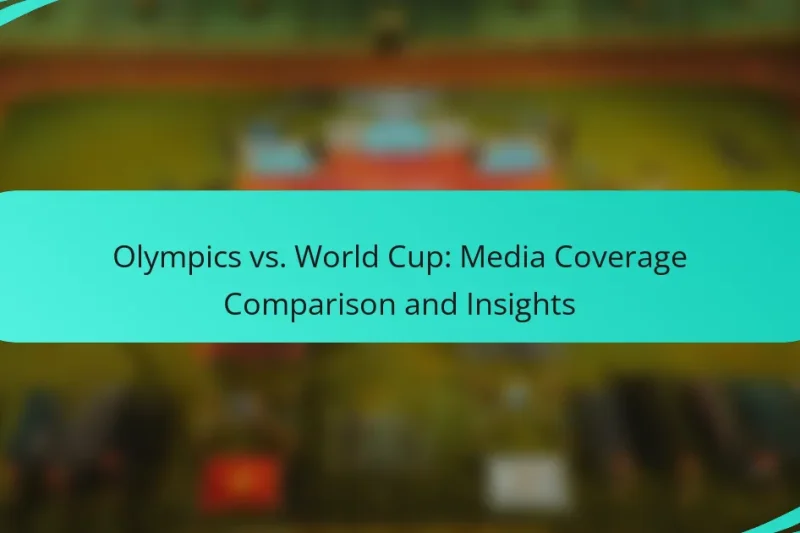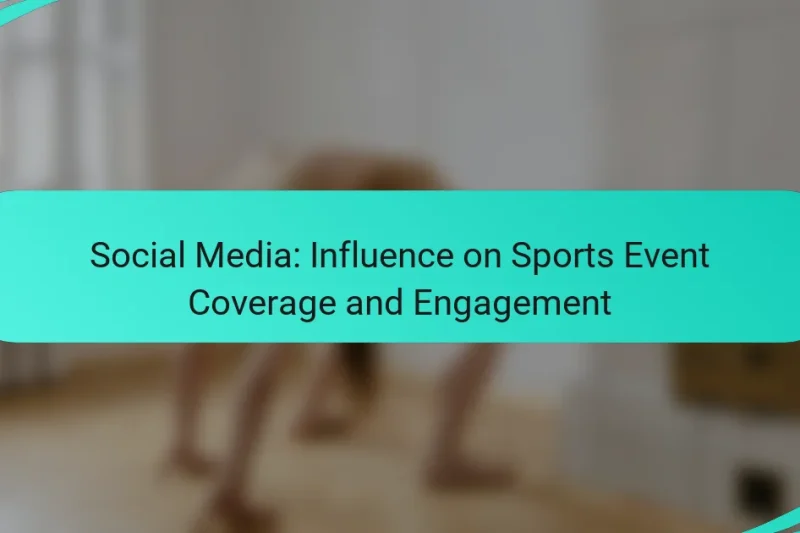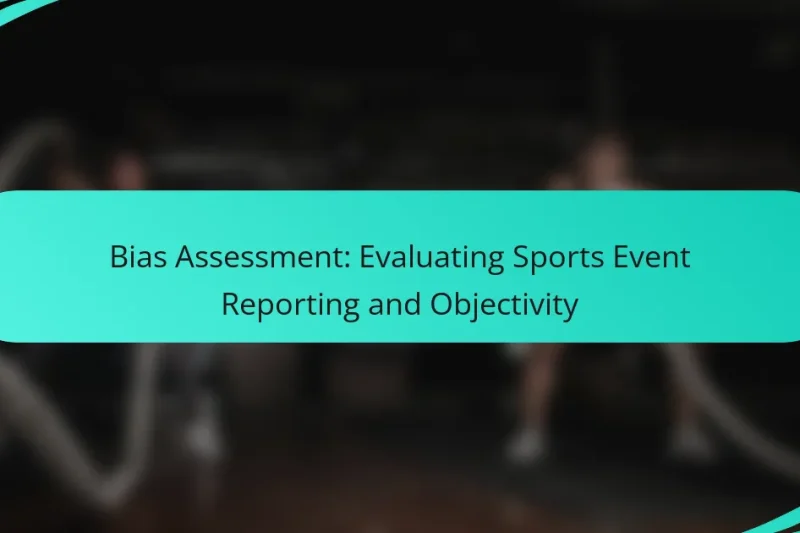The media coverage of the Olympics and the World Cup presents distinct differences in scope, focus, … Olympics vs. World Cup: Media Coverage Comparison and InsightsRead more
Media Coverage Analysis of Major Sports Events
Media coverage analysis of major sports events is essential for understanding the influence and effectiveness of narratives surrounding these high-profile occasions. By employing a mix of quantitative metrics and qualitative assessments, stakeholders can gauge reach, engagement, and sentiment, ultimately revealing the impact of media on audience perception and brand visibility.
Sports Journalism Quality: Evaluation Metrics and Standards
Evaluating the quality of sports journalism involves a comprehensive analysis of various metrics that reflect the … Sports Journalism Quality: Evaluation Metrics and StandardsRead more
Audience Perception: Media Coverage of Sports Events and Reactions
Media coverage plays a crucial role in shaping audience perception of sports events by framing narratives … Audience Perception: Media Coverage of Sports Events and ReactionsRead more
Social Media: Influence on Sports Event Coverage and Engagement
Social media has transformed the landscape of sports event coverage by offering fans immediate access to … Social Media: Influence on Sports Event Coverage and EngagementRead more
Bias Assessment: Evaluating Sports Event Reporting and Objectivity
Bias assessment in sports event reporting is crucial for ensuring fair and accurate coverage. By analyzing … Bias Assessment: Evaluating Sports Event Reporting and ObjectivityRead more
How is media coverage analyzed for major sports events?
Media coverage for major sports events is analyzed through a combination of quantitative metrics, qualitative assessments, and comparative analysis. This multifaceted approach helps stakeholders understand the reach, impact, and effectiveness of media narratives surrounding these events.
Quantitative metrics
Quantitative metrics involve numerical data that can be measured and analyzed. Common metrics include viewership numbers, social media engagement rates, and the frequency of media mentions. For instance, a major football match might attract millions of viewers and generate thousands of tweets per minute during key moments.
Tracking these metrics allows analysts to gauge the popularity and visibility of an event. Tools like Google Analytics and social media analytics platforms can provide insights into audience demographics and engagement patterns, helping to identify trends over time.
Qualitative assessments
Qualitative assessments focus on the content and context of media coverage rather than just the numbers. This includes analyzing the tone of articles, the framing of narratives, and the presence of key themes or messages. For example, a sports event might be covered positively, emphasizing athlete achievements, or negatively, focusing on controversies.
Conducting interviews with journalists and media professionals can also provide insights into how stories are crafted and the motivations behind coverage choices. This deeper understanding can reveal biases and highlight the influence of media on public perception.
Comparative analysis
Comparative analysis involves evaluating media coverage across different events or time periods to identify patterns and shifts. This can include comparing how various sports are covered or analyzing changes in coverage before and after significant events, such as rule changes or major sponsorship deals.
For instance, comparing the media coverage of the Olympics to that of the FIFA World Cup can uncover differences in audience engagement and narrative focus. Utilizing tools like media monitoring services can streamline this process, allowing for efficient side-by-side comparisons of coverage metrics and themes.
What are the key metrics for media coverage analysis?
The key metrics for media coverage analysis include reach and impressions, engagement rates, and sentiment analysis. These metrics help evaluate the effectiveness and impact of media coverage for major sports events.
Reach and impressions
Reach refers to the total number of unique individuals who see the media coverage, while impressions indicate the total number of times the content is displayed, regardless of whether it was clicked or viewed. Understanding these metrics helps assess the visibility of a sports event across various platforms.
For example, a major football championship might achieve a reach of several million viewers, with impressions in the tens of millions. Tracking these figures can guide future marketing strategies and content distribution efforts.
Engagement rates
Engagement rates measure how actively audiences interact with the content, typically calculated as the ratio of interactions (likes, shares, comments) to total reach or impressions. High engagement rates indicate that the audience is not only seeing the content but is also interested in it.
For instance, a sports event’s social media post might have an engagement rate of around 5-10%, suggesting strong viewer interest. Monitoring these rates can help identify which types of content resonate best with the audience.
Sentiment analysis
Sentiment analysis evaluates the emotional tone of the audience’s reactions to media coverage, categorizing responses as positive, negative, or neutral. This metric provides insights into public perception and can influence future media strategies.
For example, if a sports event garners predominantly positive sentiment, it may encourage sponsors to invest more heavily. Tools that analyze social media comments or news articles can help quantify sentiment, guiding teams in their public relations efforts.
How do major sports events impact media coverage?
Major sports events significantly enhance media coverage by attracting large audiences and generating extensive discussions across various platforms. This increased attention leads to heightened visibility for the events and the associated brands, creating a dynamic environment for media engagement.
Increased visibility
Major sports events draw significant media attention, resulting in increased visibility for the athletes, teams, and sponsors involved. For instance, events like the FIFA World Cup or the Olympics can lead to millions of viewers tuning in, which amplifies coverage across television, online platforms, and social media.
This visibility not only benefits the events themselves but also enhances the profiles of participating brands and sponsors. Companies often see a surge in brand recognition and recall during these high-profile occasions.
Audience engagement spikes
During major sports events, audience engagement typically spikes as fans actively participate in discussions and share content related to the events. Social media platforms experience a surge in activity, with fans posting updates, sharing highlights, and engaging in real-time conversations.
Brands can leverage this engagement by creating targeted campaigns that resonate with the heightened interest. For example, live polls, interactive content, and hashtag campaigns can effectively capture the attention of engaged audiences during these events.
Brand partnerships
Major sports events often lead to lucrative brand partnerships, as companies seek to align themselves with the excitement and visibility these events provide. Sponsorship deals can range from simple logo placements to comprehensive marketing campaigns that include exclusive content and promotions.
Brands should carefully consider their partnership strategies, focusing on aligning their values with the event’s audience. Successful partnerships can result in increased sales and long-term brand loyalty, especially when executed with authenticity and relevance to the event’s themes.
What tools are used for media coverage analysis?
Media coverage analysis utilizes various tools to evaluate the reach and impact of sports events. These tools help organizations track mentions, sentiment, and engagement across different platforms, providing valuable insights into audience perception and media effectiveness.
Meltwater
Meltwater is a media intelligence platform that offers comprehensive monitoring and analytics for media coverage. It allows users to track news articles, social media posts, and broadcast mentions related to specific sports events. With customizable dashboards, organizations can visualize data trends and measure the effectiveness of their media strategies.
One key feature of Meltwater is its sentiment analysis, which helps determine public perception of an event. This can be particularly useful for sports teams and sponsors looking to gauge fan reactions and adjust their messaging accordingly.
Cision
Cision is another powerful tool for media coverage analysis, focusing on public relations and media outreach. It provides access to a vast database of journalists and influencers, enabling users to distribute press releases effectively. Cision also offers analytics to measure the impact of media campaigns on audience engagement.
With Cision, organizations can track their media coverage in real-time, allowing for quick adjustments to strategies based on performance metrics. This tool is especially beneficial for sports organizations aiming to enhance their visibility and engagement with fans.
Google Analytics
Google Analytics is widely used for tracking website traffic and user behavior, making it a valuable tool for analyzing media coverage related to sports events. By setting up specific goals and tracking events, organizations can measure how media coverage drives traffic to their websites and engagement with their content.
To effectively use Google Analytics for media analysis, sports organizations should focus on metrics such as referral traffic from media sources and user engagement rates. This data helps in understanding which media outlets are most effective in reaching target audiences and can inform future media strategies.
How does media coverage vary by sport?
Media coverage varies significantly by sport, influenced by factors such as audience size, sponsorship deals, and cultural relevance. Football generally attracts the most extensive media attention, while sports like tennis and basketball have distinct strategies tailored to their fan bases.
Football coverage trends
Football coverage is characterized by extensive broadcasting rights and a global audience, leading to high competition among networks. Major leagues, such as the English Premier League and UEFA Champions League, often dominate sports news, with coverage including live broadcasts, highlights, and in-depth analysis.
Digital platforms have increasingly become essential for football coverage, allowing fans to access real-time updates and behind-the-scenes content. Social media plays a crucial role, with clubs and players engaging directly with fans, enhancing the overall viewing experience.
Basketball media strategies
Basketball media strategies focus on dynamic storytelling and player personalities, which resonate well with younger audiences. The NBA, for instance, leverages social media to promote highlights and engage fans through interactive content, making the sport more accessible and appealing.
Coverage often includes a mix of traditional broadcasting and streaming services, catering to diverse viewing preferences. This dual approach allows fans to follow games live or catch up with highlights at their convenience, maximizing audience reach.
Tennis event analysis
Tennis event analysis typically revolves around major tournaments like Wimbledon and the US Open, which receive substantial media coverage. Coverage includes live match broadcasts, player interviews, and expert commentary, providing fans with a comprehensive understanding of the events.
In addition, tennis media coverage often emphasizes player rivalries and historical context, enhancing viewer engagement. The use of digital platforms for live scoring and match statistics has become increasingly popular, allowing fans to stay updated on their favorite players in real-time.
What are the challenges in media coverage analysis?
Media coverage analysis faces several challenges, including ensuring data accuracy and addressing bias in reporting. These factors can significantly influence the interpretation and perception of major sports events.
Data accuracy
Data accuracy is crucial in media coverage analysis as it affects the reliability of insights drawn from the information. Inaccurate statistics or misrepresented facts can lead to misleading conclusions about team performance or audience engagement.
To ensure data accuracy, analysts should cross-reference information from multiple reputable sources, such as official league statistics and recognized sports news outlets. Regular audits of data collection methods can also help maintain high standards of accuracy.
Bias in reporting
Bias in reporting can skew public perception and create an uneven portrayal of events or teams. This bias may stem from various factors, including personal opinions of journalists, media ownership, or regional loyalties.
To mitigate bias, analysts should evaluate coverage from diverse media outlets and consider the context in which reports are produced. Understanding the potential for bias can help in forming a more balanced view of the event being analyzed.




